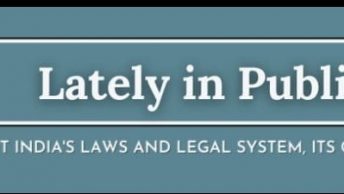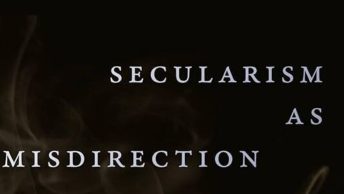But we should also understand, as in Jaitley’s own admission, there is a world of difference between the response of Hindus and the members of other religions to such alleged insult to religious sentiments. The defining characteristic of Hinduism is tolerance, and despite the fringe elements making a strong case for assertion of rights against Chandramohan, not many were indeed moved by this plea. On the contrary, there were many who pleaded a lenient response, as the issue was one of artistic freedom and expression. This is as it should be, as it sets Hinduism apart from other religions. The issue is certainly not majority bashing, as Mr.Jaitley would have us believe.
Chandramohan can perhaps claim in his defence that he did not intend to hurt the sentiments, and therefore did not violate the provisions of the IPC sections, Sections 153 A and S.295, as his paintings were strictly meant for peer review. Just one instance would suffice to show that even if an alleged violation of these sections had taken place in the public realm, the test was to see whether the bulk of the population was hurt or considered it as an outrage – not necessarily because the complainants said so. I am giving below the brief judgment of Bombay High Court dismissing in limini a petition to ban printing of pictures of Hindu goddesses in fire crackers. (Bhau v. State of Maharashtra, 1999 Cr.LJ 1230 (Bom).
“It is a fact that photographs of God and Goddesses of Hindu religion are being pasted on the fire crackers. This is not happening for the first time, but this practice is going on since last many years and up-till-now nobody has raised any objection regarding this practice. That has happened only because nobody thought it objectionable, nobody’s feeling were hurt on seeing the firecrackers bursting and the photographs destroying because the photographs on the fire crackers were not being looked at as photographs of God and Goddesses but just some prints to attract the attention of the customers. There was no intention that anybody’s feeling should be hurt by selling such fire crackers or by bursting such fire crackers. Now altogether new dimension is being given to this matter. Nobody from Hindu community up-till-now has thought over on this issue in this way. It is just whim of the petitioners and for that they have come before the Court. This is nothing but wasting time, money and energy.
If anybody from the petitioners feels that by bursting the fire crackers on which there are photographs of God and Goddesses, he may stop himself using such fire crackers for his own purposes because only his feelings are being hurt, but he should not take the matter in his hands as if he is representing whole of the society when whole of the society is not looking to the matter from that point of view.”
Mr.Jaitley makes much about the ECHR’s decision in the Visions of Esctasy case. He would do well to read this article in Observer, which makes a strong case for the repeal of the Blasphemy law in England, and also refers to other cases, where the pleas for invoking Blasphemy law were ignored as they lacked any merit. The author of this article asks: “Has the time not arrived to repeal Britain’s outdated blasphemy law? Only then will we have an even playing field in which freedom of speech is genuinely sacrosanct, and all religions (and their critics) are granted the same level of protection in the UK.” I am not suggesting that we should do away with our S.153 A or S.295 of Indian Penal Code, as they are useful to maintain communal peace in our plural society. But the tests for invoking these sections must be transparent and stringent, rather than be left to the fringe groups, who intend to ignite passions where there are none.






The argument that perceived insults or blasphemous behaviour towards Hinduism needs to be treated on a separate level than other religions that have a narrow definition of blasphemy is very open ended. With this sweeping characterization of “tolerance” it can then be stretched to allow any level of insult without warranting any justified legal response. Because Hinduism lacks a unified dogma or a church or leadership,
and the adherents are multifarious, even an outrageous assault on one of its specific aspects can then be found as “tolerated” or ignored by significant sections of its adherents. To impute that as a green light would be a gross violation to those that indeed get offended. The real test is to consider if a comparable insult against a similar number of people in a different class would be passable or not. We are now witness to a deplorable arm-twisting of an elected government of Punjab by a group of “high-church” clergymen of the Sikh Religion to enforce their notion of “blasphemy” on the whole state, rather the whole country. If we were to strengthen the rule of law, and to enable the State to firmly overrule such injunctions, which I believe would be the intent of many of us, it is imperative that we deal with this free speech-expression/blasphemy issue in a fair and equitable manner across the board.
this piece in the telegraph is one of the few that describes the art work in question and reflects on its artistic merit – http://www.telegraphindia.com/1070520/asp/opinion/story_7801102.asp
Thanks to Mr.Venkatesan for his clarification. But my point about how we protect the sensibilities of those Hindus that indeed get offended has not been answered. We cannot have “noise” testing as a basis nor can we measure the “agitation” levels as indicators. If we do then we incentivise the strident elements to further organize and polarize the society. I am not sure the “state-level” “success” of lathi wielding and sword brandishing groups to close shutters and stop trains can be taken as a true measure of the sentiment of the entire Sikh community. Also we have to take into account the strict ecclesiastical nature of the Sikh Panth and the enormous power wielded by the SGPC in the religious affairs of its community.
Sikh clergy can ostracize and ex-communicate any of its adherent by religious edicts. It has extra-ordinary ability to make the community fall in line. Remember the images of Buta Singh polishing shoes at the Harmandir Sahib? By definition Hinduism lacks such characteristics. So to mandate the a large majority of Hindus to express their outrage collectively before offering any legal protection is to set the bar very high and to deny the sensibilities of frankly a large number of people. I hope I don’t need to add that I support the Bajrang dal tactics for my views to be considered seriously.
Ironically, the same ‘artist”s paintings on Muhammad outraged Muslims in Baroda. They not only threatend University and Police but raised slogans in favor of Bin Laden along with his posters. This news is not covered in secular media and secularists keep quite on these issues. See photograph and related story ( it is in Gujarati though) here: http://www.deshgujarat.com/news